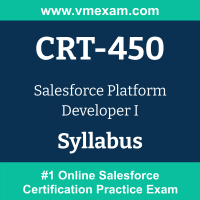 The Salesforce CRT-450 exam preparation guide is designed to provide candidates with necessary information about the Platform Developer I exam. It includes exam summary, sample questions, practice test, objectives and ways to interpret the exam objectives to enable candidates to assess the types of questions-answers that may be asked during the Salesforce Certified Platform Developer I exam.
The Salesforce CRT-450 exam preparation guide is designed to provide candidates with necessary information about the Platform Developer I exam. It includes exam summary, sample questions, practice test, objectives and ways to interpret the exam objectives to enable candidates to assess the types of questions-answers that may be asked during the Salesforce Certified Platform Developer I exam.
It is recommended for all the candidates to refer the CRT-450 objectives and sample questions provided in this preparation guide. The Salesforce Platform Developer I certification is mainly targeted to the candidates who want to build their career in Salesforce Developer domain and demonstrate their expertise. We suggest you to use practice exam listed in this cert guide to get used to with exam environment and identify the knowledge areas where you need more work prior to taking the actual Salesforce Platform Developer I exam.
Salesforce CRT-450 Exam Summary:
|
Exam Name
|
Salesforce Platform Developer I |
| Exam Code | CRT-450 |
| Exam Price |
Registration fee: USD 200 Retake fee: USD 100 |
| Duration | 105 minutes |
| Number of Questions | 60 |
| Passing Score | 68% |
| Recommended Training / Books |
Study for the Platform Developer I Exam Prepare for Your Salesforce Platform Developer I Credential Apex Specialist Build Applications Programmatically on the Salesforce Platform (DEX450) Prepare for your Platform Developer I Certification Exam (CRT450) |
| Schedule Exam | Kryterion Webassessor |
| Sample Questions | Salesforce CRT-450 Sample Questions |
| Recommended Practice | Salesforce Certified Platform Developer I Practice Test |
Salesforce Platform Developer I Syllabus:
| Section | Objectives | Weight |
|---|---|---|
| Developer Fundamentals |
- Understand multi-tenant concepts and design frameworks, such as MVC architecture and Lightning Component Framework.
- Given a scenario, identify common use cases and best practices for declarative versus programmatic customizations, including governor limits, formula fields, and roll-up summaries. - Given a scenario, determine, create, and access the appropriate data model including objects, fields, relationships, and external IDs. - Given a scenario, identify the options and considerations when importing and exporting data into development environments. |
23% |
| Process Automation and Logic |
- Identify the capabilities of the declarative process automation features. - Declare variables, constants, methods, and use modifiers and Apex interfaces. - Given a scenario, use and apply Apex control flow statements. - Given a scenario, write SOSL, SOQL, and DML statements in Apex. - Given a scenario, follow best practices to write Apex classes and triggers. - Given a scenario, identify the implications of governor limits on Apex transactions. - Describe the relationship between Apex transactions, the save order of execution, and the potential for recursion and/or cascading. - Implement exception handling in Apex, including custom exceptions as needed. - Given a scenario, use declarative functionality and Apex together to automate business logic. |
30% |
| User Interface |
- Given a scenario, display content or modify Salesforce data using a Visualforce page and the appropriate controllers or extensions as needed. - Describe the Lightning Component framework, its benefits, and the types of content that can be contained in a Lightning web component. - Given a scenario, prevent user interface and data access security vulnerabilities. - Given a scenario, display and use a custom user interface components, including Lightning Components, Flow, and Visualforce. - Describe the use cases and best practices for Lightning Web Component events. - Given a scenario, implement Apex to work with various types of page components, including Lightning Components, Flow, Next Best Actions, etc. |
25% |
| Testing, Debugging, and Deployment |
- Write and execute tests for triggers, controllers, classes, flows, and processes using various sources of test data. - Given a scenario, know how and when to use the Salesforce Developer tools such as Salesforce DX, Salesforce CLI, and Developer Console. - Describe how to approach debugging system issues and monitoring flows, processes, and asynchronous and batch jobs, etc. - Describe the environments, requirements, and process for deploying code and associated configurations. |
22% |
